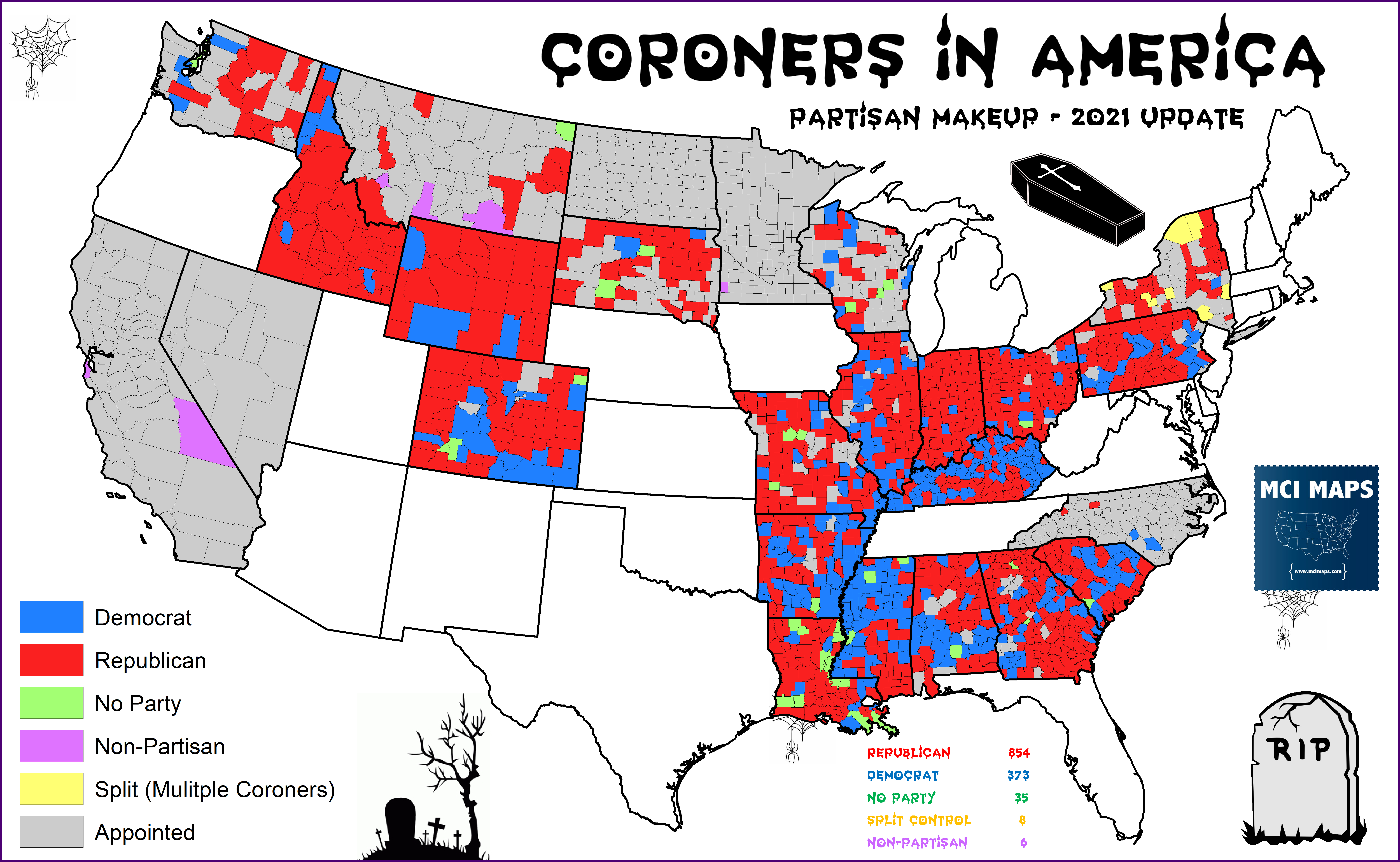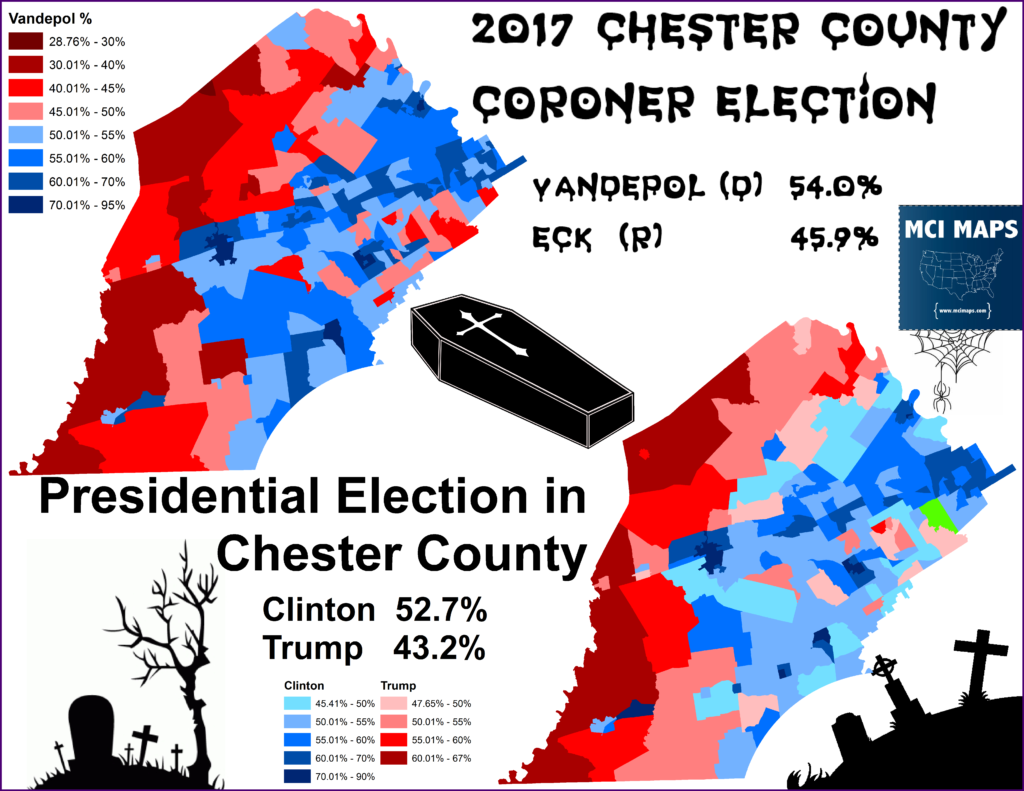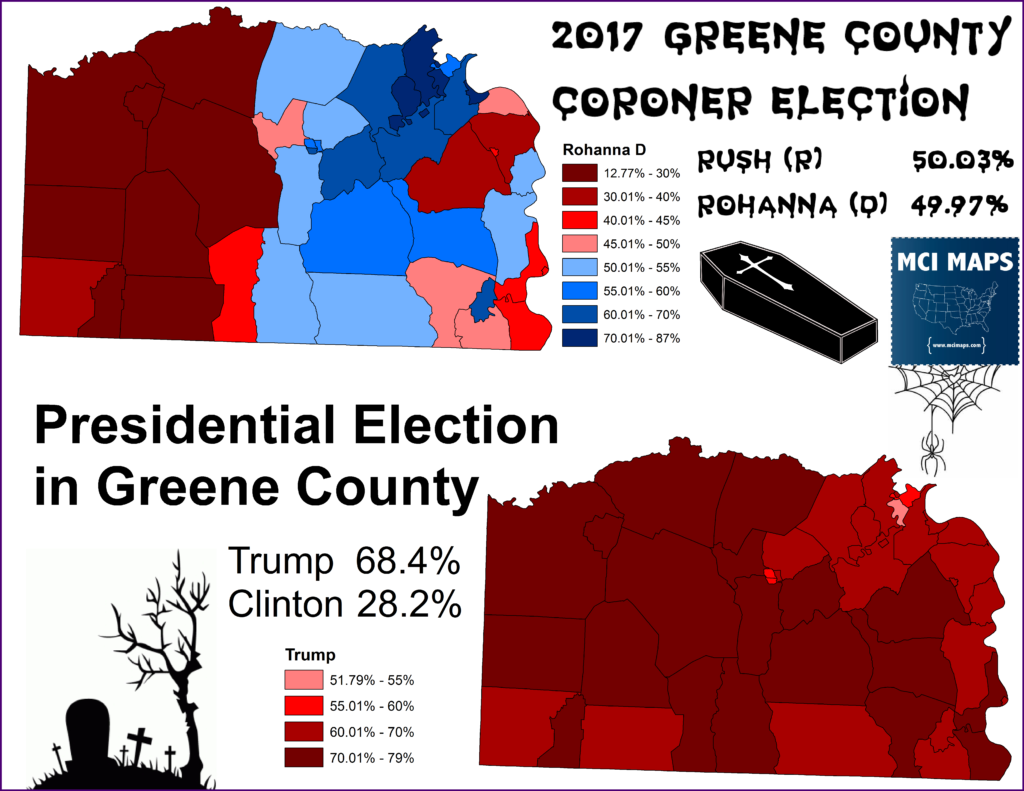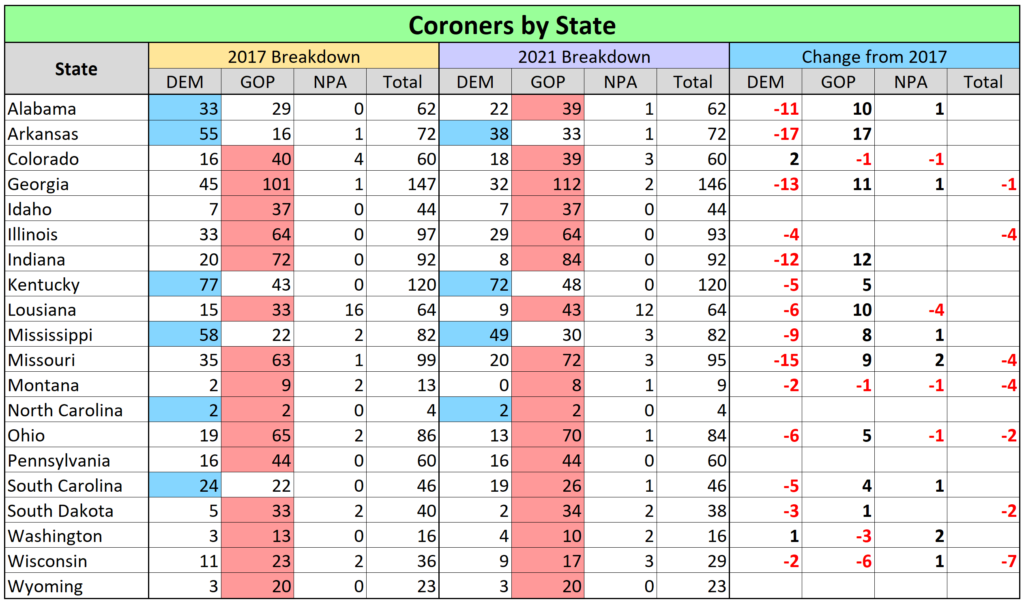In 2017, I did a deep-dive into the election of coroners in America. To my amazement, over 1200 counties in American still used a system that elected coroners to office. Many states and counties have moved to medical examiner systems – where trained professionals are hired by governments to handle death investigations. Elected coroners can be required to have training or degrees via state law, but many states have few pre-requisites to run for the job. If a county has an elected coroner position, it is likely on a partisan ballot line – the same as other local offices.
The election of coroners can cause problems; namely via conflicts of interest and lack of training. I delved into this issue more in my 2017 issue; which I recommend checking out for more details on that topic. Since then, nothing has fundamentally changed. Calls for reform continue and several counties have moved to appointed positions since my last write-up.
For Halloween 2021, I decided revisit my 2017 article and see how party affiliation has changed in the four years since. By now, all counties have gone through an election cycle where coroner would be up.
Where Are Coroners Elected?
The coroner system in American is largely the same as it was in 2017. As best I can tell, 1270 counties still elect coroners on partisan ballots. A handful of counties in Montana, California, and Minnesota do non-partisan elections. Compared with 2017, a handful of additional counties moved to appointed coroners. Minnesota, for example, went from 3 elected coroners to just 1. Montana increased its number of counties where the office of “Sheriff-Coroner” is elected.
In a funny example of how obscure this office is – in 2017 I missed the fact that four North Carolina counties still elect coroners. I only found this out via on an article at the time about one of them wishing to end their elections – but needing state legislative approval.
Based on the data readily available, this is the coroner system in America. All blanked-out states use a form of appointed medical examiners.
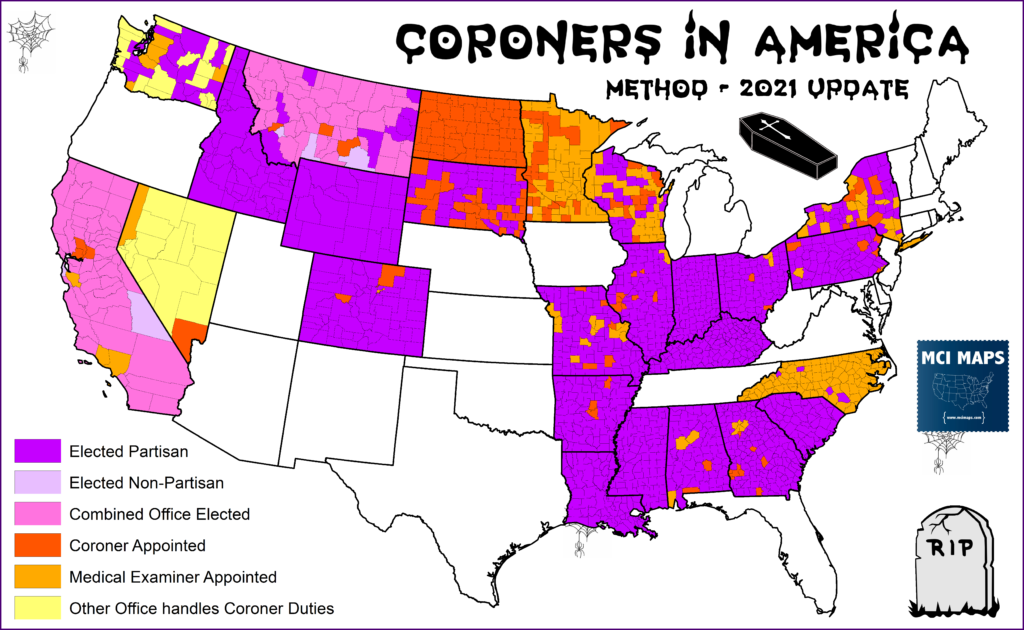
As a mentioned, a handful of counties have moved to appointed systems since 2017. Sometimes this came after no one filed for the position – or after an ordinance was passed. This reform, however, is not always popular. See the example out of McHenry County – a Republican-leaning exurb of Chicago. A referendum took place in 2020 to make the office appointed – but that measure easily failed. This measure was also swamped in local political drama, and while reasons to change the post were cited, it became viewed as a commission power-grab.
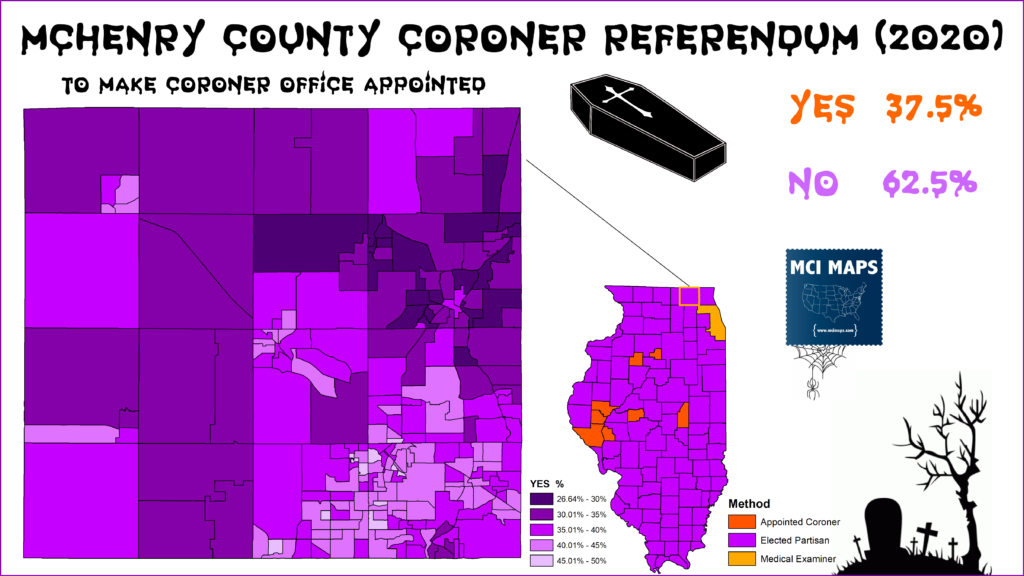
On the other side, Kitsap County elected a Coroner who ran on the pledge to move toward a Medical Examiner System. Jeff Wallis won his race, and his proposal to move to the new Medical Examiner system will actually be on this Tuesday’s ballot in the county.
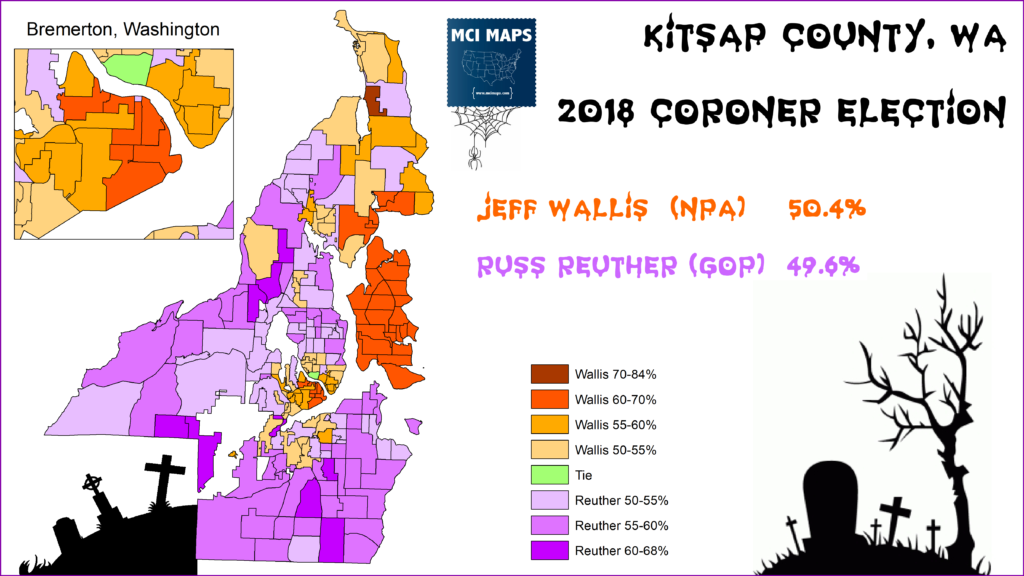
So reforms aside, we are still dealing with hundreds of elected Coroners in America. Baring a massive statewide change – I believe that the movement to appointed positions will be a slow and gradual process.
Partisan Makeup of Coroner Offices
So how do those offices break down by party? We have over 1200 counties to account for. These results come from a mix of local elected official directories, news articles, filings, and election results.

Republicans currently hold over 850 coroner positions – miles ahead of the 370+ Democratic seats. How does this compare to 2017? Well, since my 2017 article, over 100 Democratic coroner offices have swung to the GOP.
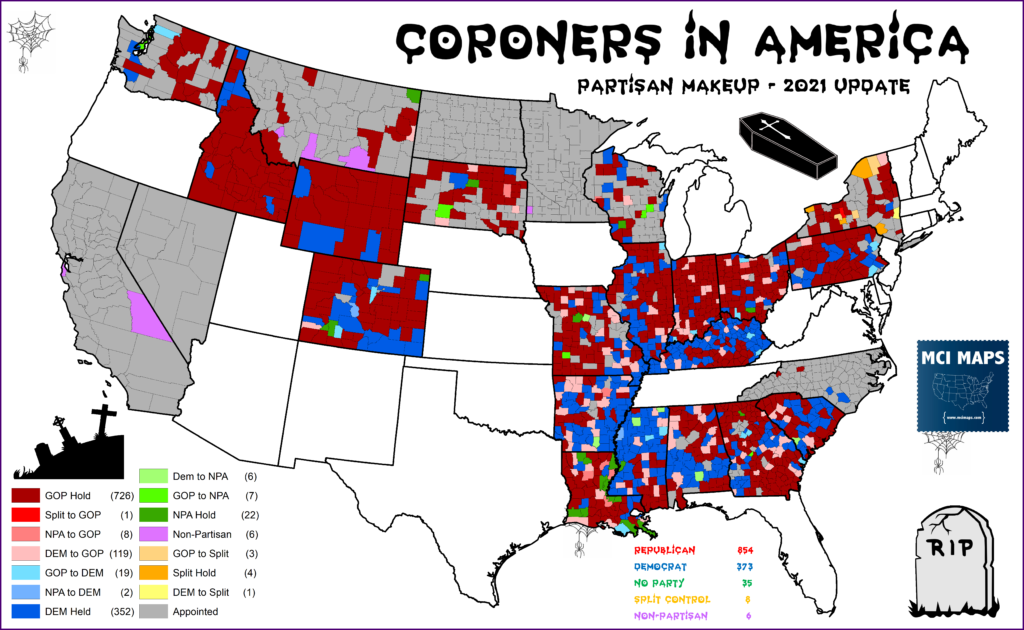
Over 100 flips. It sounds like alot, but wasn’t especially surprising to me. As I discussed in my 2017 article, Democratic coroners were dotting the deep-south and other ancestral Democratic areas. Democratic coroners were a reflection of the old rural democratic dominance that used to exist in many parts of the country. We’ve seen these local offices continue to move to the GOP in recent years. Coroners, however, are unopposed 80% of the time – allowing longtime Coroners to simple win unopposed again and again.
In fact, when I did a write-up on the 2019 coroner races in Mississippi, I found that 100% of the GOP gains came from party switching or Democratic retirements.
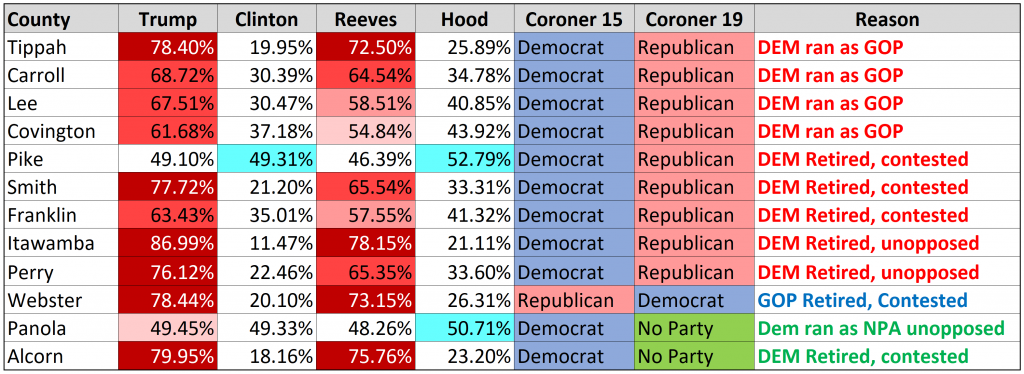
Across the nation there are examples of Democratic coroners losing. However, switching parties or retirements are the biggest driver of the flips.
So how does control of a coroner office correspond with Presidential vote. Well compared to 2017, there are still far more Democrats serving in Trump counties than there are Republicans in Biden/Clinton counties.
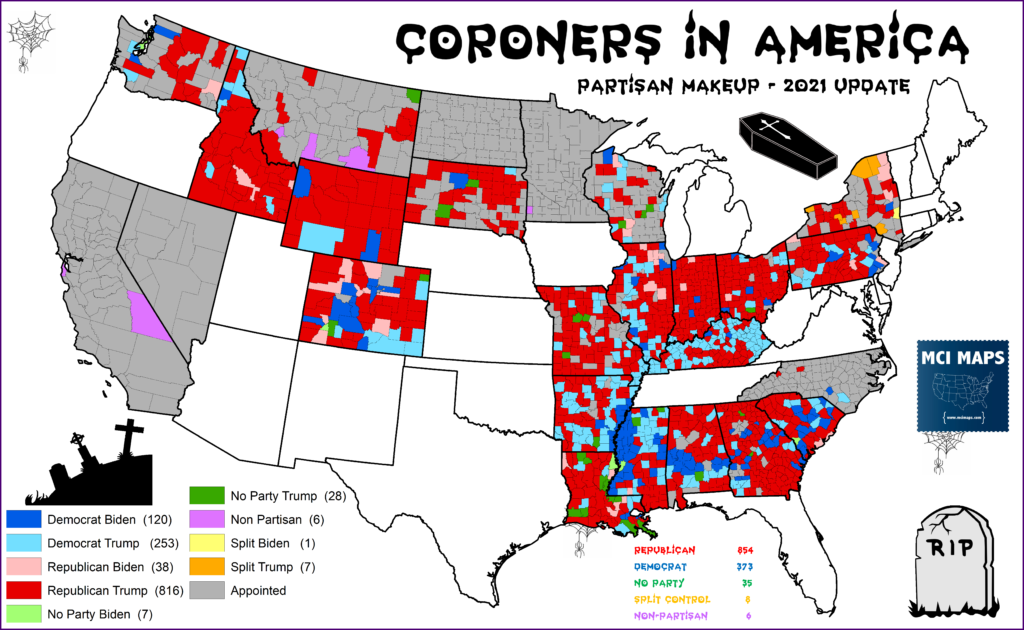
Over half of Democratic coroners sit in Trump counties.
Coroner offices are beginning to slowly converge with Presidential results. This is a result of the retirements discussed, but also parties making local offices are a higher priority. This was best seen in my article looking at the 2017 Pennsylvania coroner races. That year, Democrats in historically-red Chester county made a major push for local offices. This included Coroner, which they won by defeating the Republican incumbent. Both candidates were qualified, but the race largely was just a partisan exercise.
Meanwhile, in ancestrally-democrat Greene County, the local Republicans managed to oust the 30-year incumbent by eight votes. Similar to Chester, qualifications were not a big issue. It just became about party.
This pattern is likely to continue across states – speeding up the process begun by retirements and party switches.
With that nationwide breakdown done, lets take a quick look state-by-state changes from my 2017 article to today. This will effectively account for all coroner elections take take place after 2016 and through 2020.
State by State Breakdowns
Below I will offer state-by-state notes on Coroner positions. I will put the Presidential vote side-by-side with how the coroner offices changes since my initial article.
—–
In my 2017 article, Democrats still narrowly led Republicans in coroner positions in Alabama. It was no shock that they lost that lead when their 2018 elections came around. Republicans netted 10 offices from Democrats. In addition, Butler county saw a write-in candidate beat the Democratic nominee. This was a crazy race, as the incumbent coroner lost his primary, but then engaged in the write-in effort. I wrote about this race, and found that the write-in win was fueled by GOP votes. I decided to classify this as an NPA win.
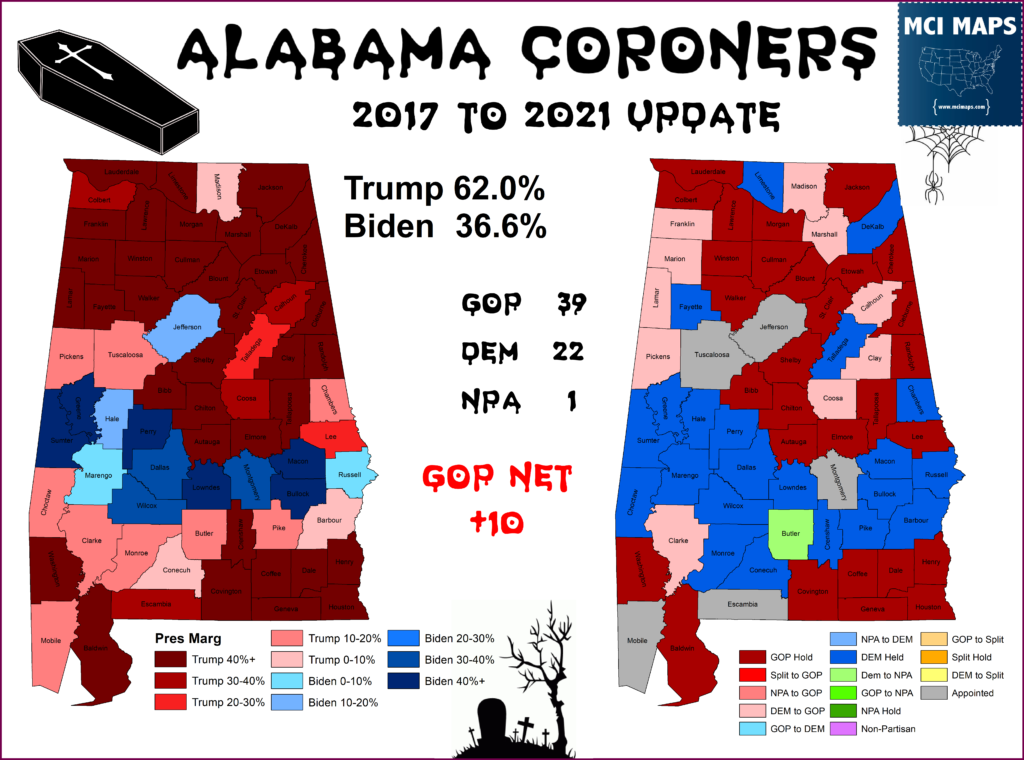
Arkansas, where Democrats were by far the most over-extended, was a massive boon for the GOP, who have netted 17 posts from Democrats. Many of these were retirements and party switches. Arkansas, coincidently, was the hardest state to research – with many counties being a real struggle to get solid answers from in short timeframes. It is entirely possible I missed some unopposed Dems who filed as Republicans for re-election.
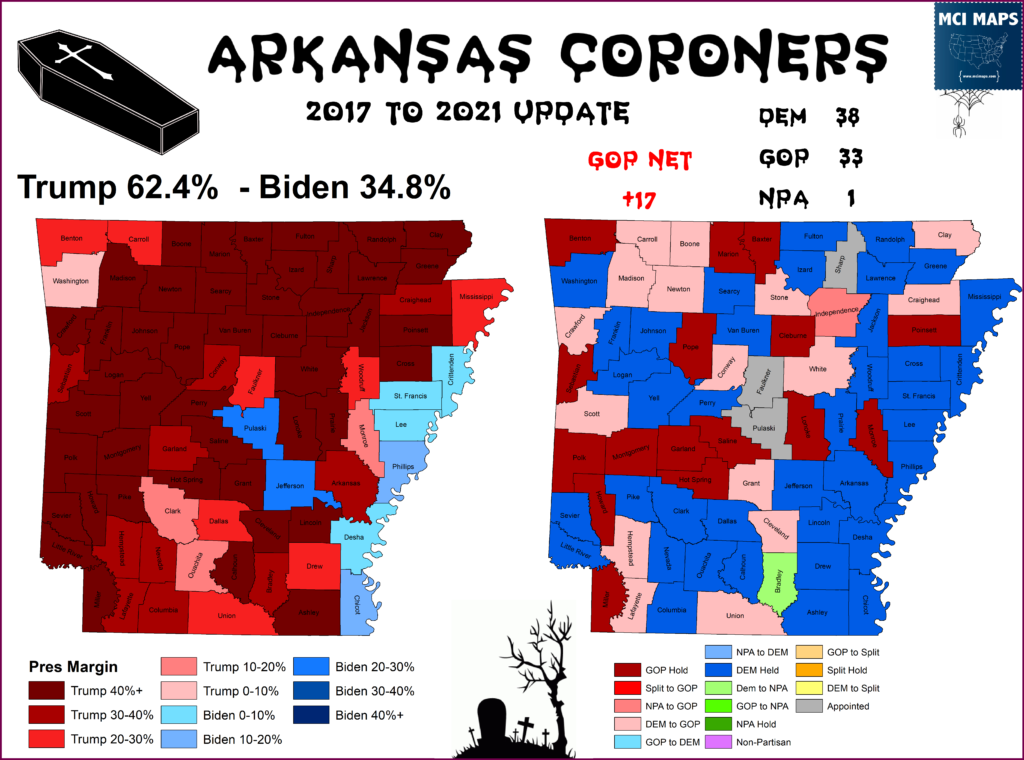
Colorado is one of just two states where Democrats made gains vs the GOP. Democrats flipped three counties – with the biggest being suburban Jefferson County. Democrats continue to hold many rural/GOP counties – and are still likely to lose some of them to retirements down the line. This Dem gain does reflect how strong Colorado is for Democrats right now.
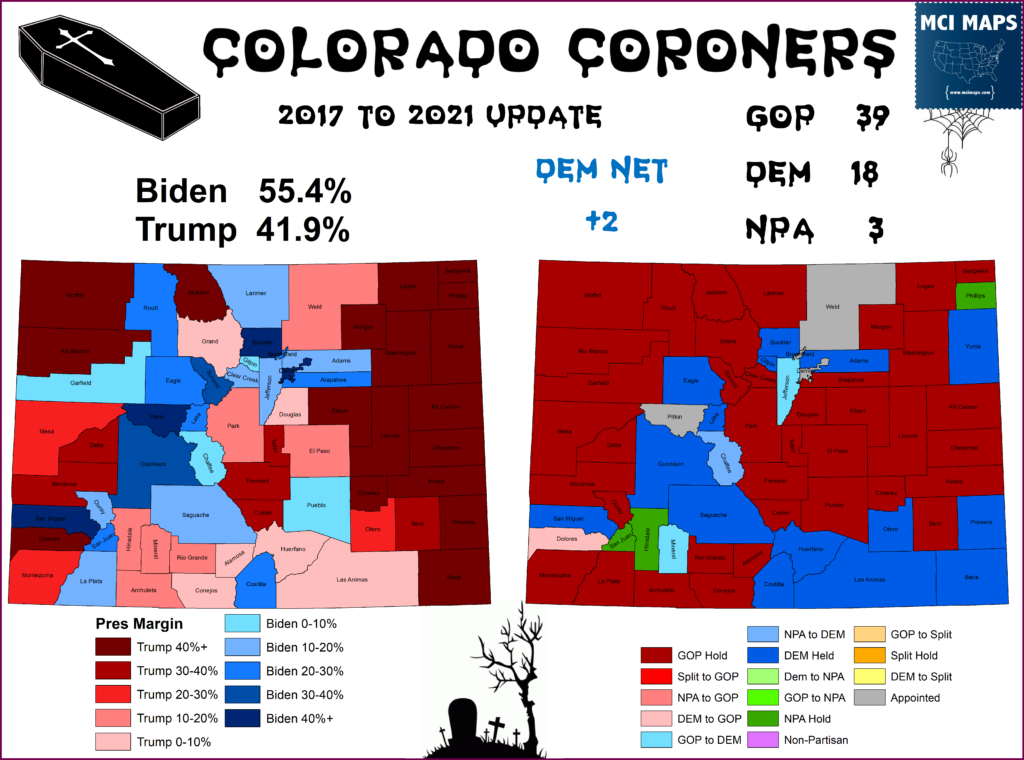
While Georgia Democrats made strong showings in 2018 and flipped the state for Biden in 2020, it didn’t stop massive GOP gains with coroner positions. Democrats net-lost 11 seats, thanks entirely to rural losses. However, Democrats made gains around Savanna and Atlanta – a reflection of the urban-rural divide filtering its way down-ballot.
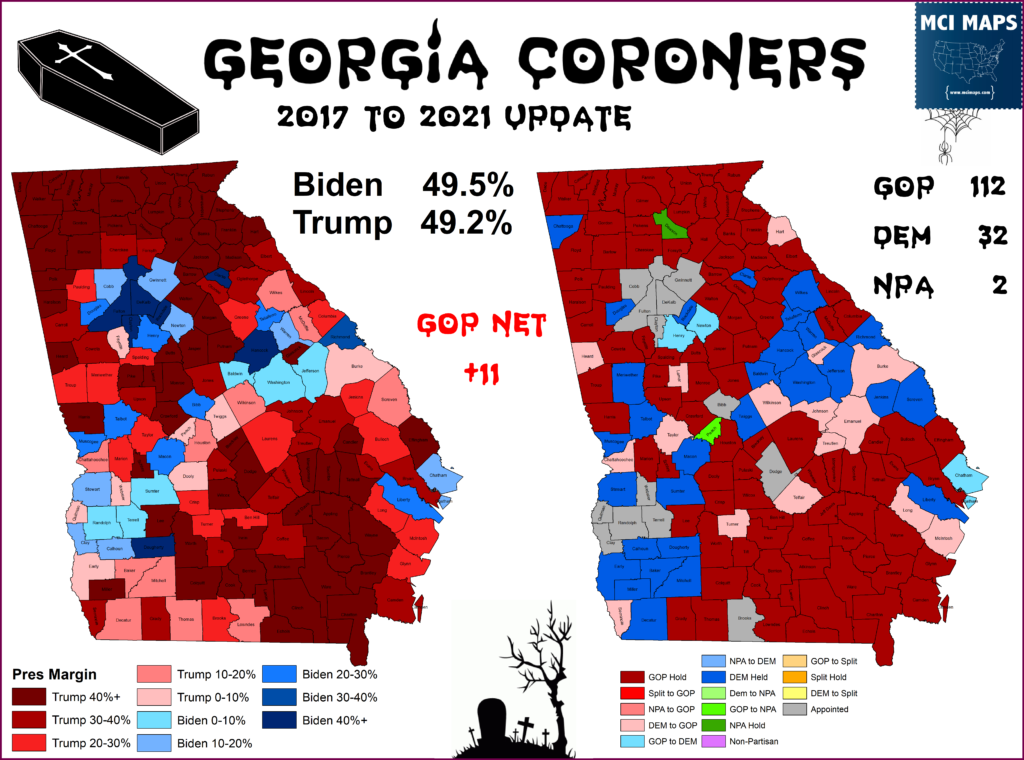
In Idaho, there was only one major race – the Ada County coroner election. The Democratic incumbent, Dotti Owens, fended off a tough challenger in 2018 – holding the lean-GOP seat. Owens was greatly aided by the former Coroner, a Republican, emphatically stating she was the most qualified.
Democrats still maintain a handful of northern panhandle seats as well. Meanwhile, the Republicans continue to hold deep-blue Blaine county. Why? In 2018, the Republican incumbent was unopposed. This is also what saved many of the panhandle Dems.
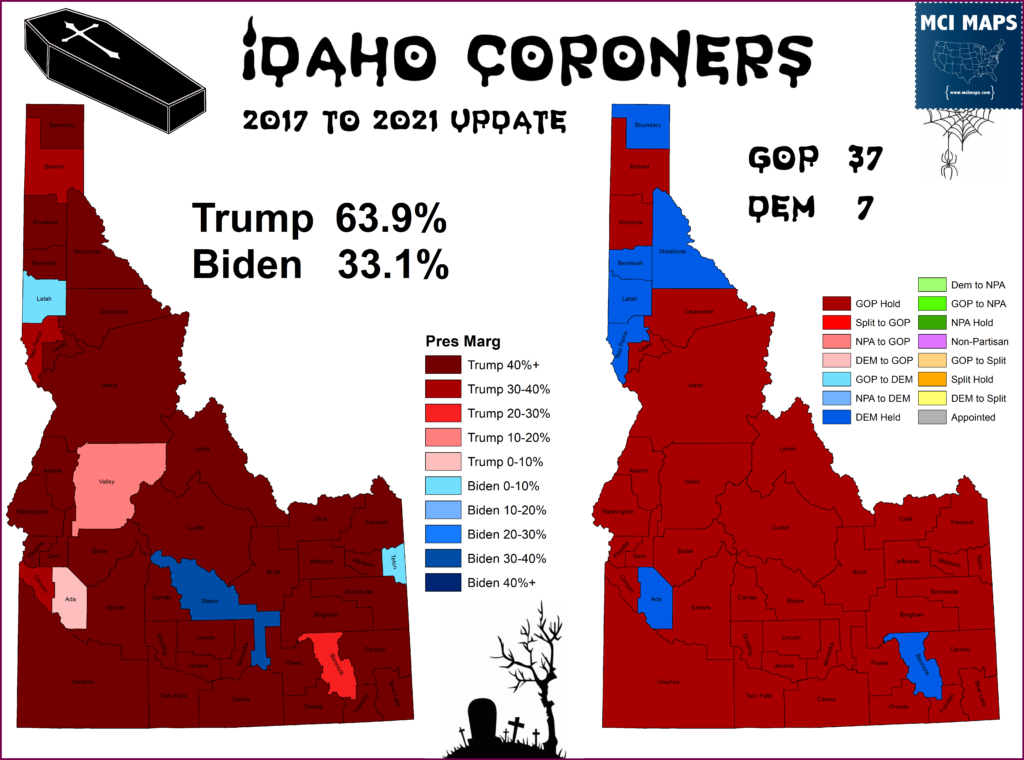
Illinois saw several coroner positions go to appointments. On top of this, Republicans made some down-ballot gains – while Democrats flipped suburban Lake County. Similar to Georgia, this reflects the shifting rural-urban divide. Democrats came within a hair of flipping the DuPage coroner post as well.
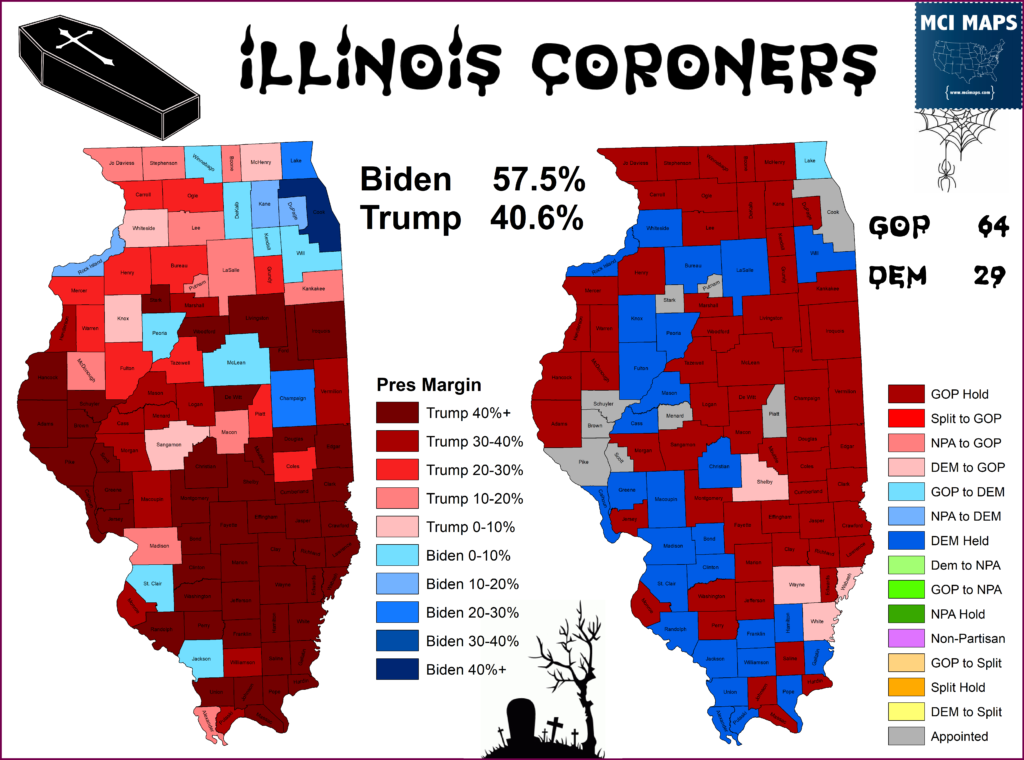
Indiana was another blood-bath for Democrats. More rural counties fell to Republicans – though Democrats did make some shock gains – which are often from Democratic unopposed replacements. A chunk of counties were up in 2018 and others in 2020.
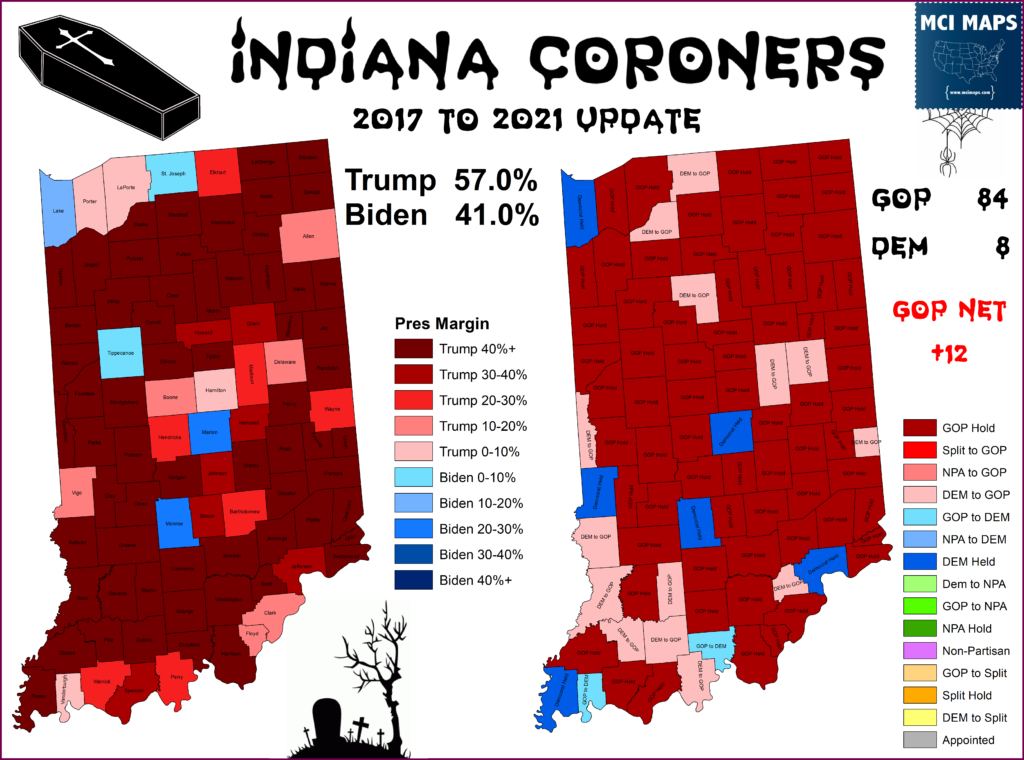
Kentucky, despite having a huge Democratic batch of coroners, did not see massive GOP gains when their offices came up for a vote. Republicans made eight gains, but Democrats made three of their own. Kentucky stands as the best state for Democratic coroners in American.
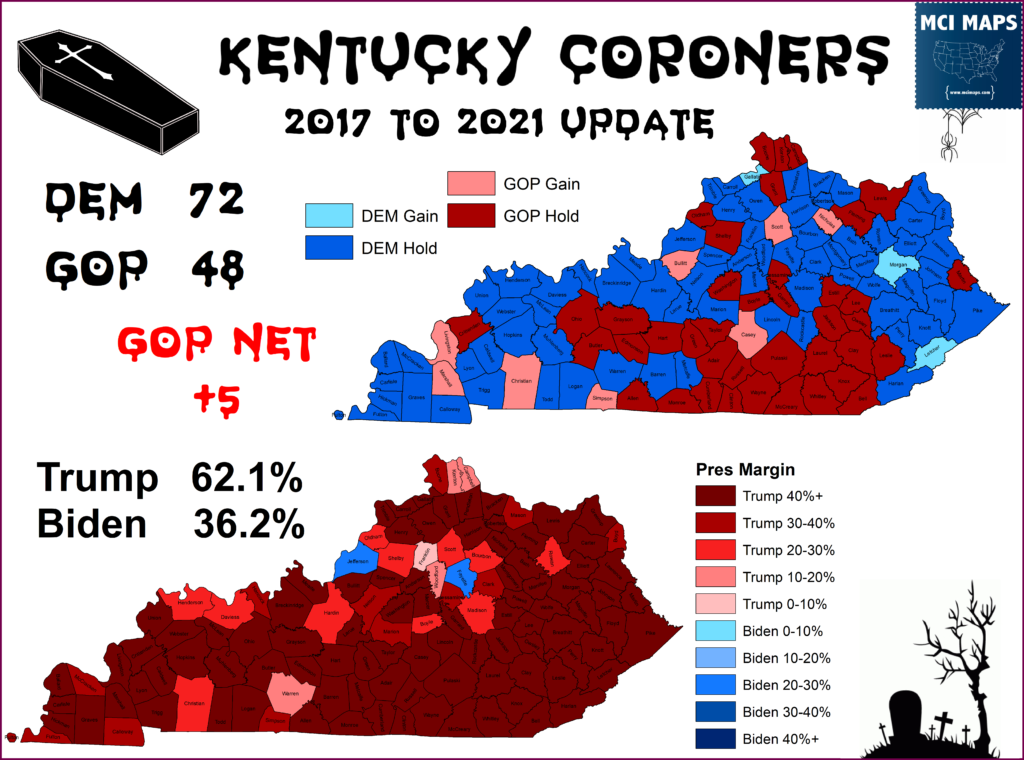
Lousiana has been a boon for Republicans when it comes to coroner offices. Republicans have netted 10 seats from Democrats since 2017. Lousiana also continues to lead in total number of candidates winning offices as non-partisan despite having partisan ballots. The lone Democratic gain was in Terrebonne, where a GOP coroner passed away and the successor, Charles Ledoux, was the only candidate to file.
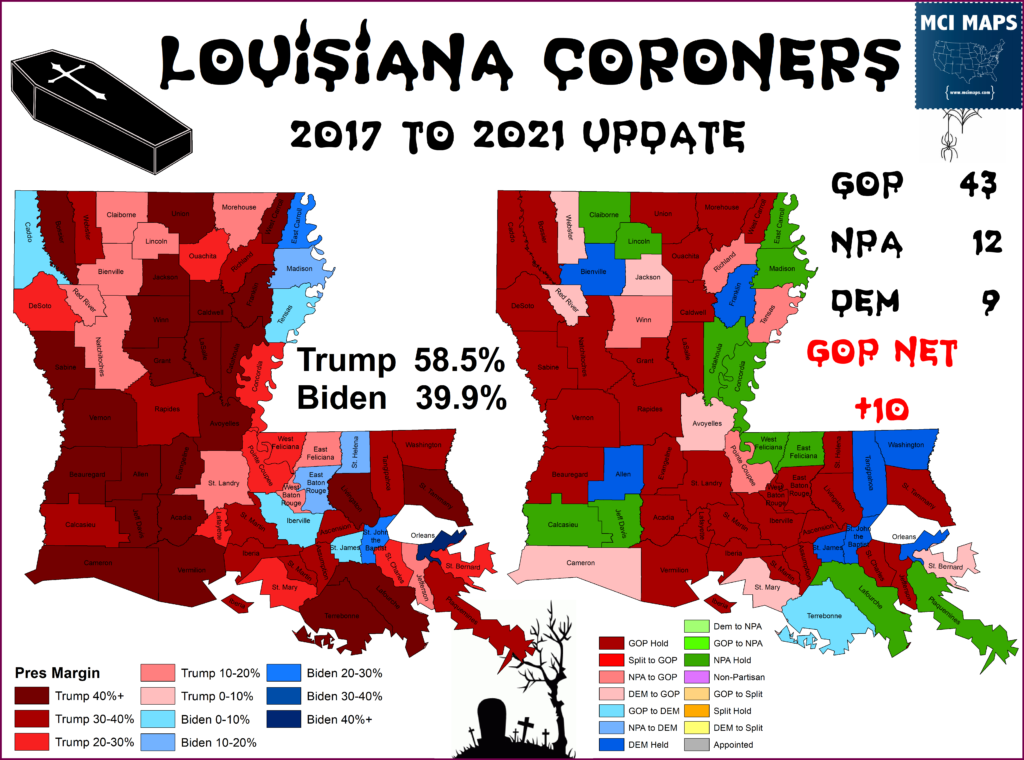
As discussed before, Republican gains in Mississippi’s coroner races were entirely retirements or party switches. Even still, Democrats made some gains as well. The Webster flip is still stunning – which I covered in my Mississippi coroner article.
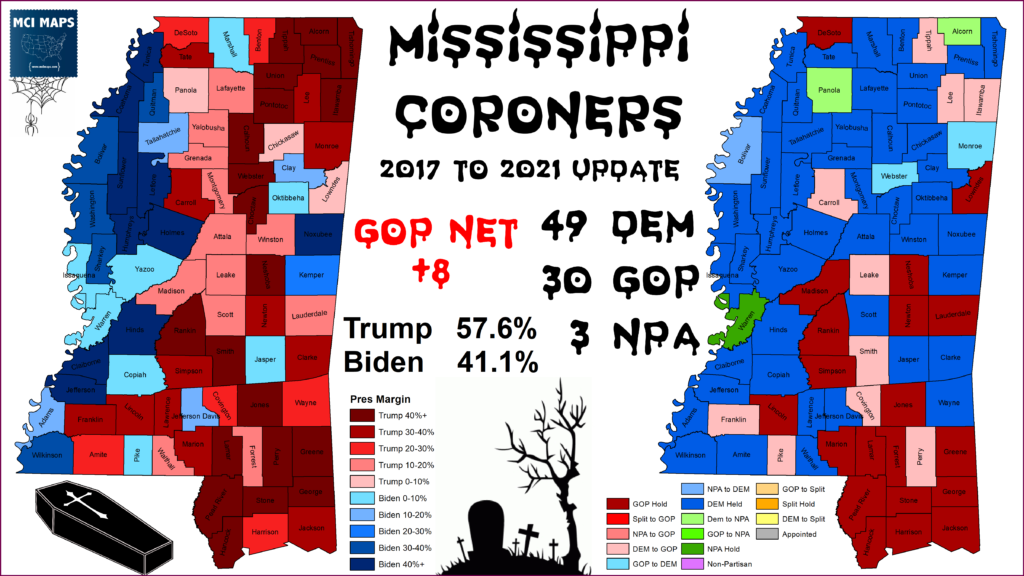
Missouri was bad for Democrats as well. A state where Biden only won three counties (all which have appointed offices) – there is likely to be continued Democratic losses as time goes on. You still have a batch of Democratic coroners in ancestral Democratic regions – including the SE boot.
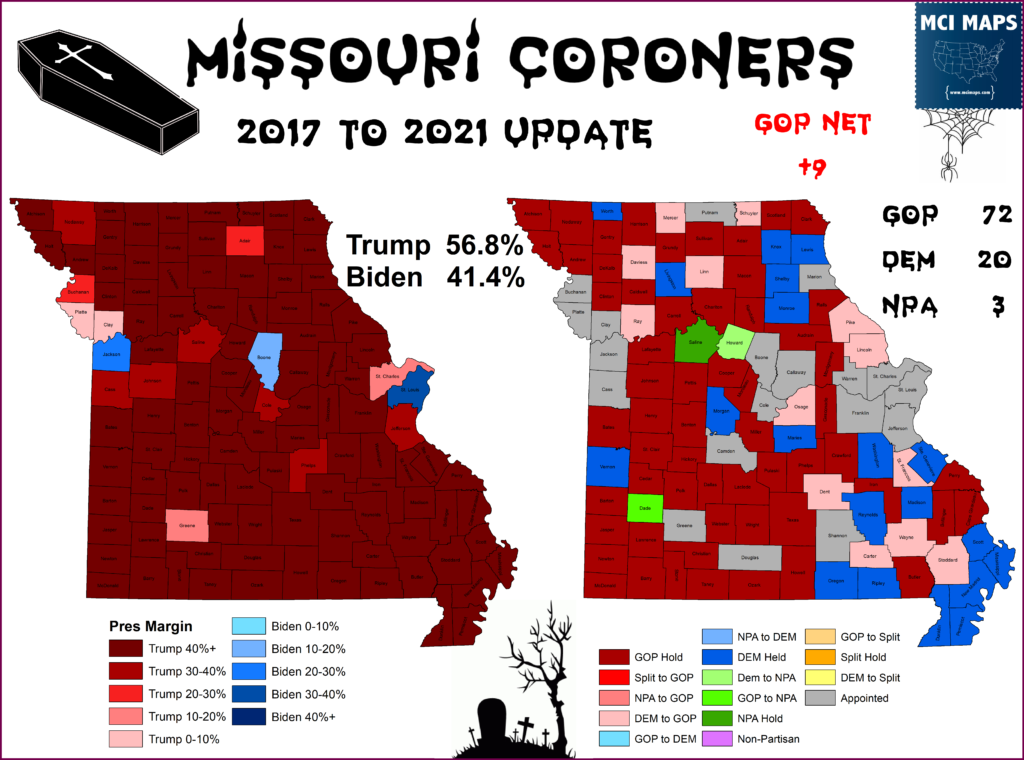
Montana saw a several counties move to appointed coroners – or added counties to the list of those electing a “Sheriff-Coroner”. At this point, only a handful of Republican and non-partisan coroners remain. I think Montana is very likely to see more offices combined with Sheriff. In 2017, there were fifteen coroners in Montana. Now its down to nine.
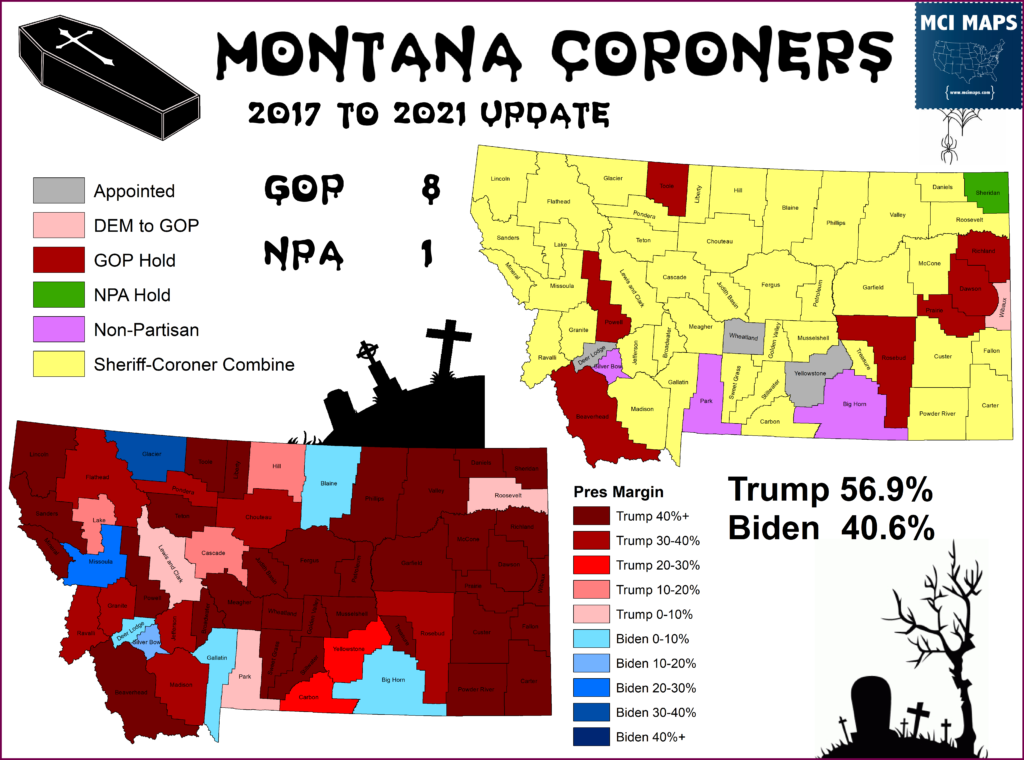
New York’s coroner system stands out from the rest of the country. The upstate counties that still elect the post often have multiple coroners. Some counties do at-large elections while others do district-level offices. Republicans dominate in coroners – a reflection of their upstate control.
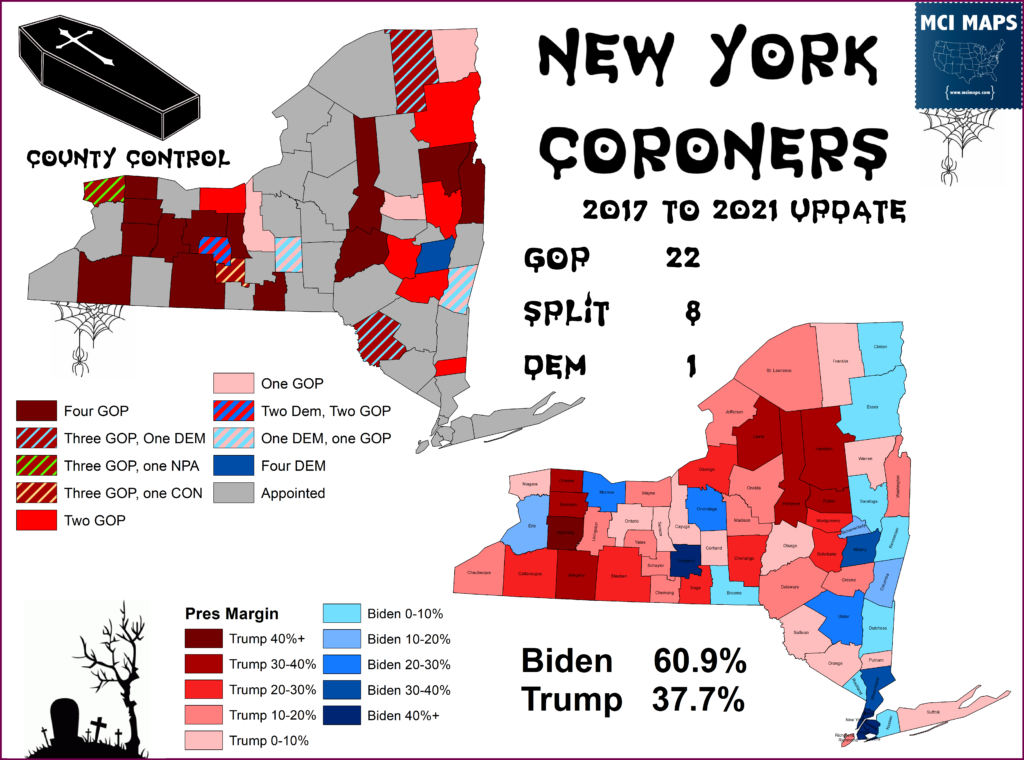
North Carolina still had four coroners elected, though Bladen is actively seeking to end the practice.

In Ohio, Democrats continued to lose rural ground to the GOP, but made gains as well. The most notable issue is Morrow and Meigs counties couldn’t even find candidates to run for the position. As such, they arranged contracts with neighboring coroners to fulfill services.

Pennsylvania has seen its county coroner posts slowly move toward matching President. Democratic flips in Monroe and Chester have been balanced by the flips in Greene and Warren. I delved deeper into the Pennsylvania races in this article.
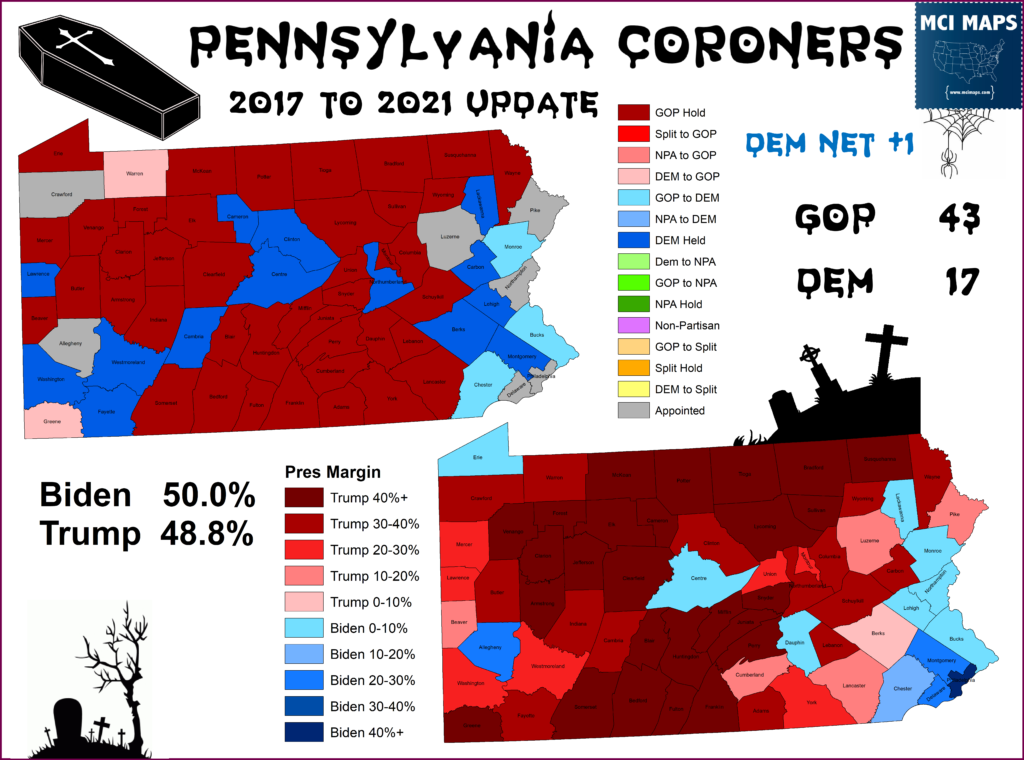
In 2017, Democrats had a narrow lead in South Carolina coroner positions. That is gone now, but Democrats still hold a large number of GOP-leaning counties. A note on the NPA gain – this was fueled by the late death of an incumbent running for re-election and a sudden NPA-heavy general (since the primary ballot was already set).
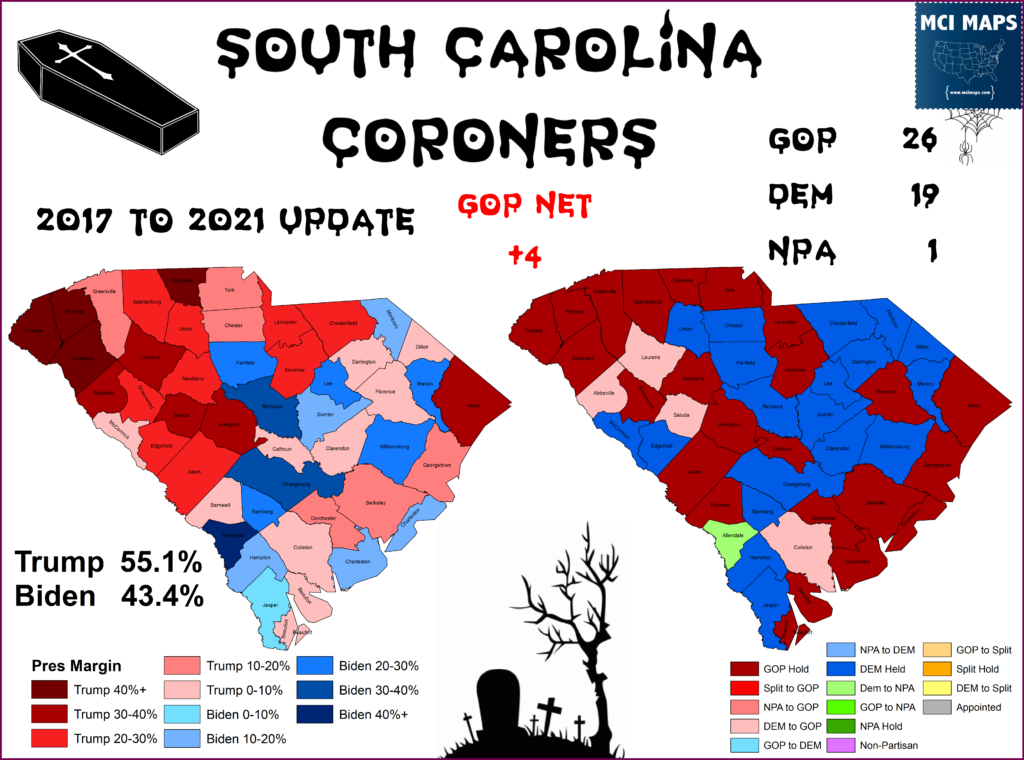
Several more South Dakota counties moved to appointed positions. Most posts that remain are rural Republican spots.
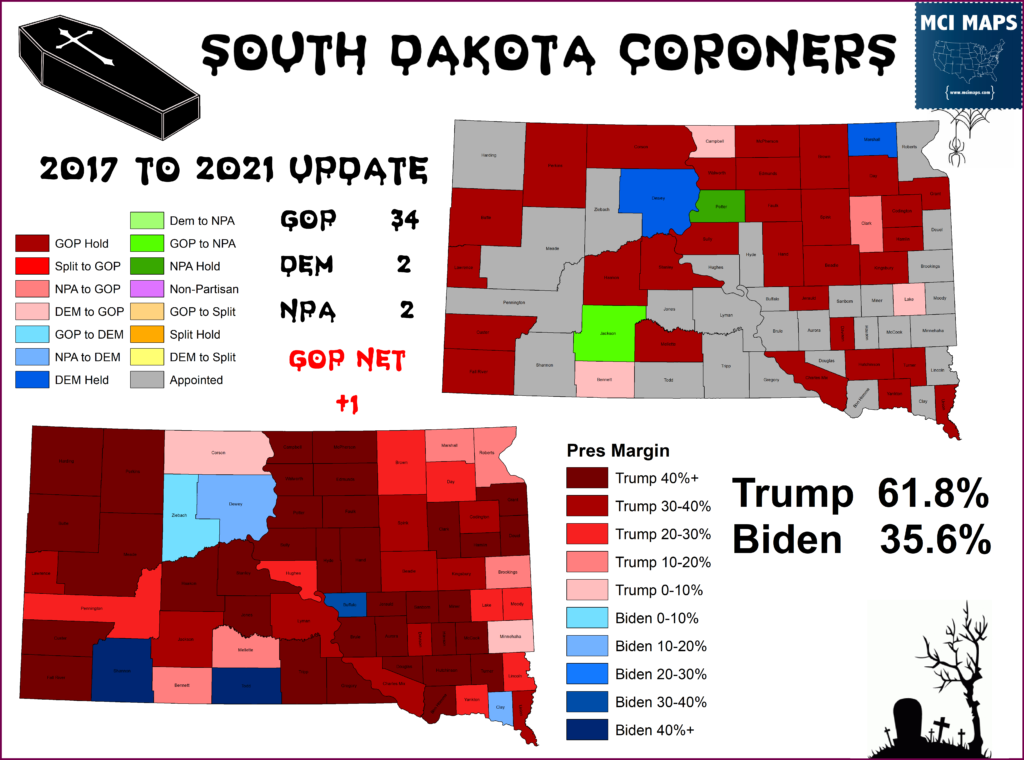
Washington’s coroner situation hasn’t changed much – though both Democrats and NPA candidates made gains in the offices. Meanwhile, reforms were recently passed in Washington that could reduce the number of elected coroners and would mandate stricter training for the posts.

Wisconsin also saw a batch of counties move toward appointments. The total elected coroners is now at 29; down from 36.
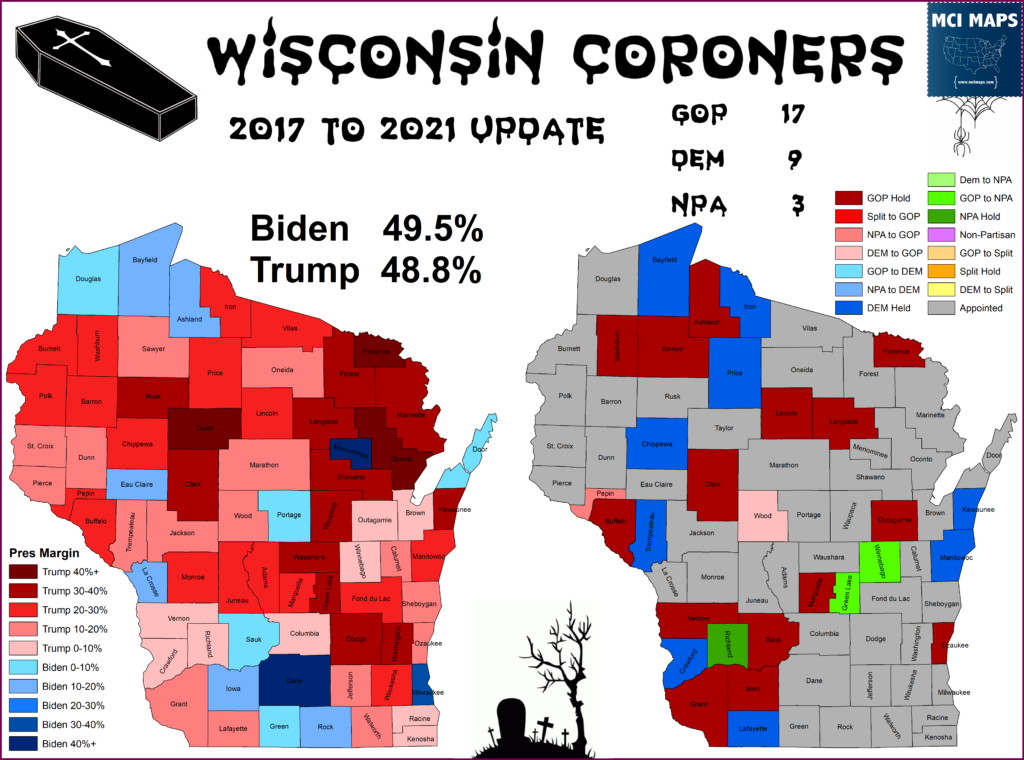
Finally, in Wyoming, the 2017 party breakdown remained – which Democrats holding three coroner posts to the GOP’s 20.
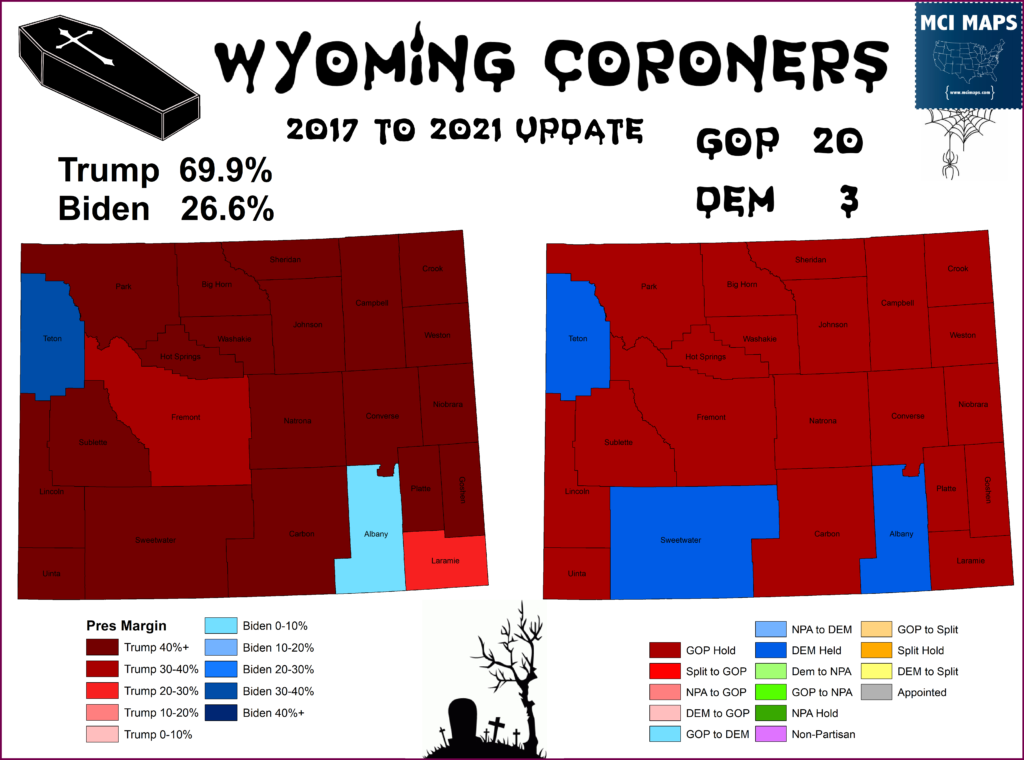
Having concluded our statewide-tour, here is a table breakdown down the results (except New York – which really deserves its own breakdown in a future article due to its unique system).
It will be interesting to keep tracking these offices by state and see how these breakdowns change with time.
Some Notable Individual Races
I want to take a fast moment to look at some specific coroner races that have popped on my radar in recent years.
—–
In my 2017 article, I delved into the contentious Lake County coroner race from 2016. That race ended with Republican Howard Cooper winning the post. However, in 2020, Democrats would sweep Lake’s local offices. Democrat Jennifer Banek, a nurse and captain in the US Army Reserves, was party of a big Democratic night in Lake. Democrats also won the State Attorney office. Both coroner candidates said working to prevent deaths via outreach and education would be major focuses.
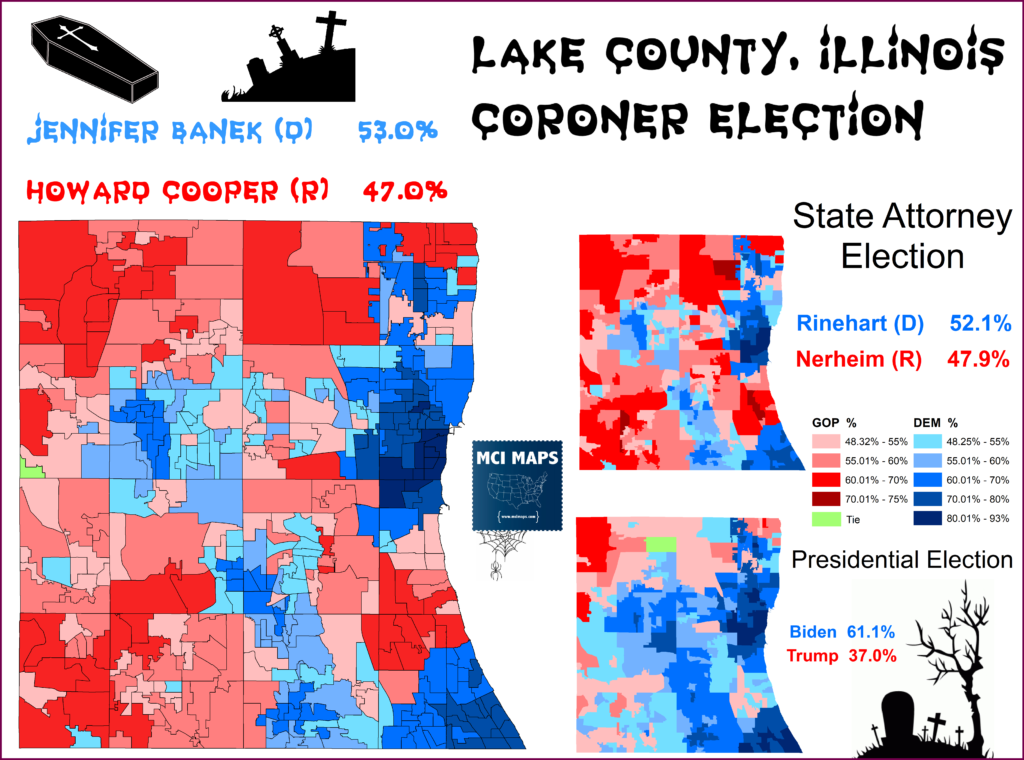
Meanwhile, in DuPage County, IL, Democrats swept local offices except for Coroner. Democrats in DuPage won county commission control for the first time since the Great Depression – but Republicans narrowly held coroner.
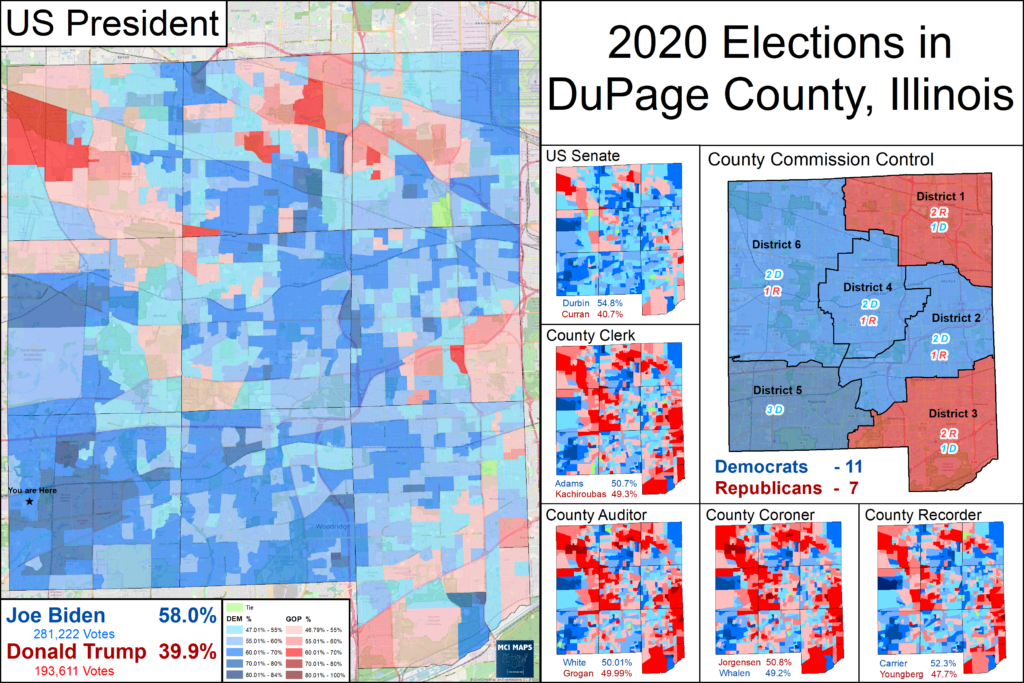
In the 2019 elections in Louisiana, Republicans managed to hold on to the East Baton Rouge coroner office. Both candidates for the office were qualified (Lousiana requires candidates to be licensed physicians). Dr Beau Clark was the incumbent since 2011; and voters clearly decided to re-elect him while splitting their ticket for Governor.
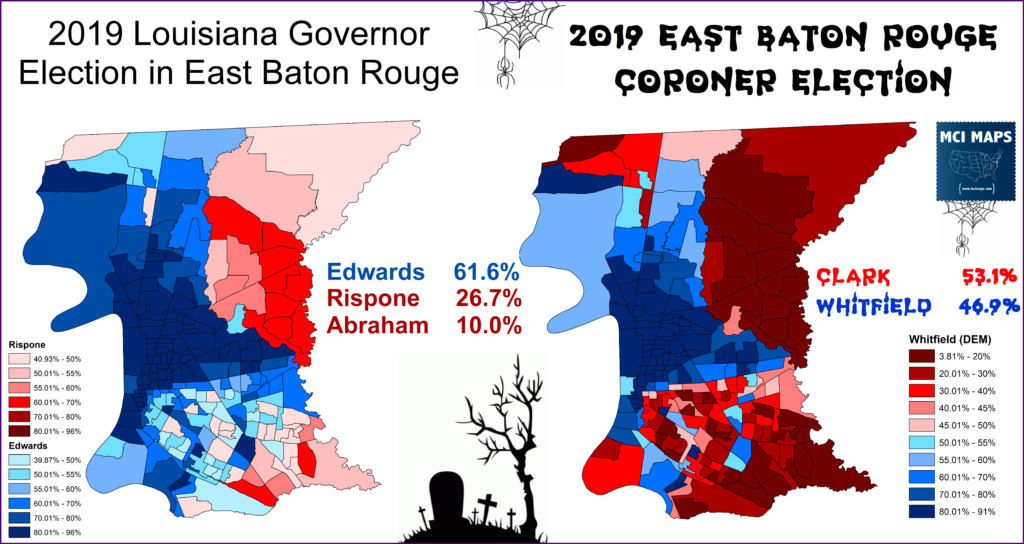
An example of party affiliation helping a flawed candidate occurred in Fayette. Incumbent Gary Ginn was being sued for sexual harassment while running for re-election in 2018. He won re-election, but under-performed the Democratic ticket.
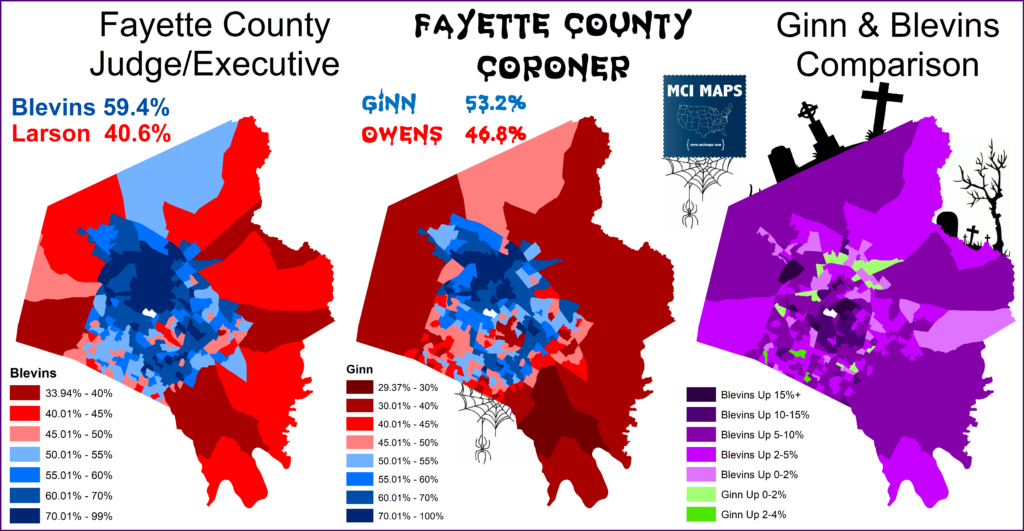
The ability of party affiliation to shield candidates is a major issue with how these offices are elected. As you can imagine, most voters don’t research these races.
Conclusions
I’ll continue to follow these races as the years go on. If you find any fun details – send them my way.
Happy Halloween!

